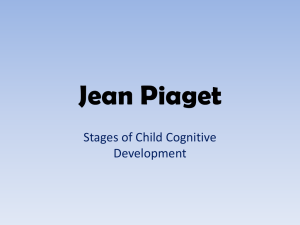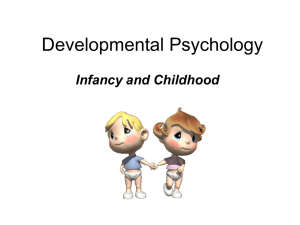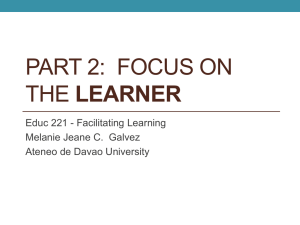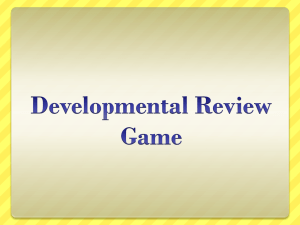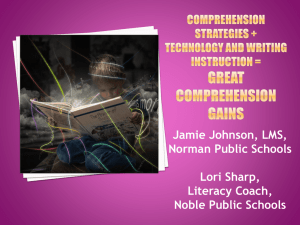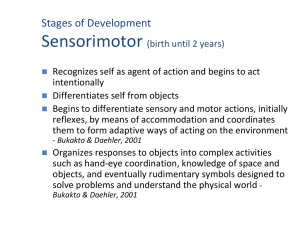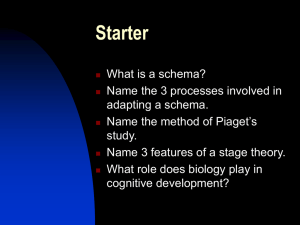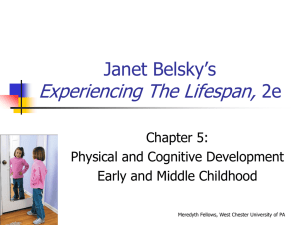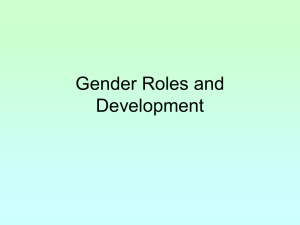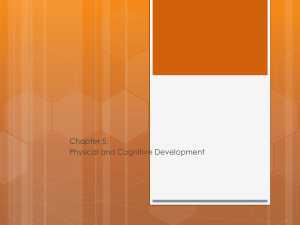Berk * Chapter 5 - Gordon State College
advertisement
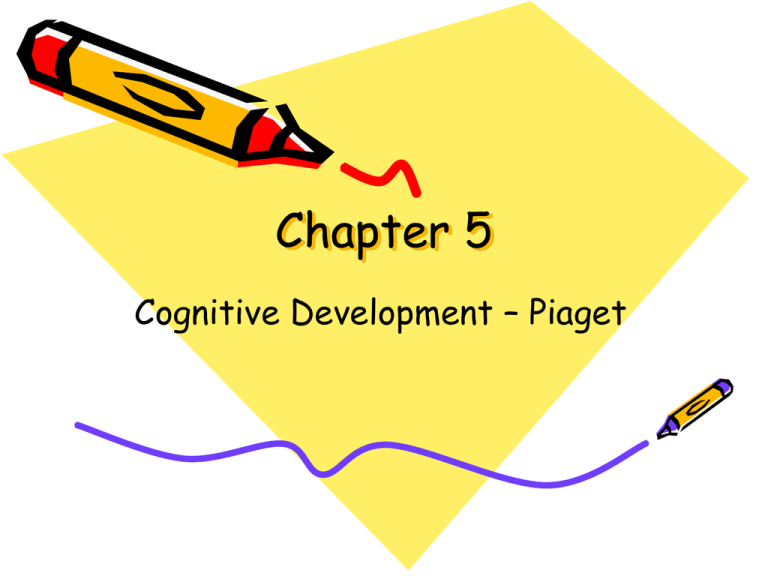
Chapter 5 Cognitive Development – Piaget Piaget’s Cognitive Developmental Theory • Schemes – organized ways of making sense of experience • Assimilation – using current schemes to interpret the external world • Accommodation – adjusting schemes or creating new ones when current ways of thinking do not fit the environment Motivation for Learning • Cognitive equilibrium – a steady, comfortable condition (more assimilation) • Cognitive disequilibrium – a state of discomfort which creates a shift toward accommodation Stages of Cognitive Development • • • • Sensorimotor Pre-Operational Concrete Operational Formal Operational Birth – 2 years 2-7 years 7-11 years 11 years onward Sensorimotor Stage • Reflexes • Circular reactions – stumbling onto a new experience caused by the baby’s motor activity – “circular” because the infant tries to repeat the event again and again Sensorimotor Stage – Repeating Chance Behavior • Newborn reflexes are the building blocks of sensorimotor intelligence • By repeating chance behaviors (primary circular reactions), reflexes come under voluntary control and become simple motor habits Sensorimotor Stage • Primary Circular Reactions (Substages 1-2) – Centers around the infant’s own bodily sensations • Secondary Circular Reactions (Substages 3-4) – Manipulation of objects and people • Tertiary Circular Reactions (Substages 5-6) – Producing novel effects, experimental Sensorimotor Substages • • • • 1) simple reflexes 2) 1st habits & primary circular reactions 3) secondary circular reactions 4) coordination of secondary circular reactions • 5) tertiary circular reactions & curiosity • 6) internalization of schemes The Sensorimotor Stage Primary Circular Reactions 1 (birth to 1 mo.) 2 ( 1-4 mos.) reflexes simple motor habits 3 (4-8 mos.) 4 (8-12 mos.) repeating, imitation intention 5 (12-18 mos.) 6 (18-24 mos.) exploration mental depictions Secondary Circular Reactions Tertiary Circular Reactions Sensorimotor Stage – Intentional Behavior • Substage 4 (8-12 months) • Deliberately coordinating schemes to reach a goal or solve a problem • Object permanence – infants retrieve hidden toys • Anticipate and try to change events Sensorimotor Stage – Gaining Object Permanence • Overall, search strategies improve during the first year. • Awareness of toy’s disappearance (violation-of-expectations research methods) • Looks for toy by 8 months (Piaget) • A-not-B search error • Invisible displacement (finds toy moved while out of sight) Sensorimotor Stage – More Recent Research • Violation-of-expectation method – infants look longer at an impossible than at a possible event • May reflect only infant’s perceptual preferences or limited awareness • Led to conclusions that infants understand, explore earlier than Piaget believed, possibly from birth • Renee Baillargeon – possible events • Carrot and screen study • Train through the box study End of Sensorimotor Stage – Mental Representations • Internal depictions of information that the mind can manipulate – Images – Concepts (categories, groups) – Sudden solutions rather than trial and error – Invisible displacement – finding a toy moved while out of sight – Deferred imitation Mental Representations (Memory) More Recent Research • Piaget says 18 months; others say 8-month olds recall object locations. • Deferred imitation, present at 6 weeks (adult facial expression). • 24-hour memory for activity board objects among 6-9-month olds. Sensorimotor Stage Evaluation • Piaget’s perspective – Skills acquired through learning, motor behavior – Vs. • Core knowledge perspective – babies are born with innate knowledge systems or prewired understandings – Physical – Linguistic numerical psychological Piaget Pre –Operational Stage The PreOperational Child • • • • Is age 2-7 Has achieved object permanence Initiates & explores Uses mental representations & symbols (language) • Is not logical During the Preoperational Stage – ages 2-7 • The child will: – Gain ability to reconstruct in thought what is experienced in behavior – Gain in ability to use symbols – words, drawings, images – Form stable concepts – By the end of the stage show an emerging capacity to reason Preoperational Symbolic Function Substage • Egocentric – – cannot take another’s point of view – Three-mountains task • Animistic – – believe inanimate objects have lifelike qualities such as wishes, feelings, intentions • Magical beliefs – Show in drawings Preoperational Intuitive Thought Substage • Intuitive thought is a combination of primitive reason and fast acquisition of knowledge. • Cannot answer the question “what if?” • Asks the question “why?” frequently. • Begin to grasp functionality – that actions and outcomes are related in fixed ways. • Begin to grasp identity-the reality that some things do not change (underlies conservation) Piaget’s Preoperational Stage • Cannot conserve – Unable to understand that certain physical characteristics stay the same even though outward appearance changes (identity) – Because of centration • Unable to classify hierarchically – Also lack reversibility Conservation and Logic, cont. Criticisms of Piaget’s PreOperational Stage • They are not egocentric, the 3 mountains task is the problem • Animism is overestimated because Piaget asked about objects like the moon with which children have little experience • They see magic as out of the ordinary, but they do attribute lifelike qualities to dolls and stuffed toys Summary Criticism of the First Two Stages • Logic develops more gradually than Piaget believed that it did • The primary problem of Piaget’s observations was complexity of the task(s) Piaget Concrete Operational Stage Concrete Operational Stage • Piaget said that thought is more logical, flexible and organized at ages 7-11. • Terms for operations they can perform – – – – Conservation Reversibility Classification Seriation (but not transitive inference) Concrete Operational Thought • Children are logical only when dealing with concrete information that they can perceive directly. • Example is a transitivity task compared to a seriation task. • Horizonal decalage – development within a stage (working out the logic of each problem separately) Piaget Formal Operational Stage Piaget – Formal Operational Stage • Starts at age 11 - 15 • Develop the capacity for abstract, scientific thinking Two Major Features • Hypothetico-deductive reasoning – Deduce hypotheses from theory – Start with possibility and end with reality – Piaget’s pendulum problem • Propositional thought – Algebra and geometry Consequences of Abstract Thought • • • • Argumentativeness Idealism Planning and indecision Self-consciousness – Imaginary audience – Personal fable Adolescent Egocentrism • Imaginary audience • Personal fable – uniqueness – destiny – invincibility Do all adults reach formal operations? • No, 40-60% of college students fail the formal operations problems. • People are most likely to reach it in subjects where they have had experience. • It may be a culturally transmitted way of thinking. Piaget & Education • Constructivist approach – set up classroom for exploration and discovery • Let learning occur naturally, facilitate • Consider the child’s knowledge & level of thinking – sensitive to readiness, accept individual differences • Use ongoing assessment Piaget and Education • Too time-consuming to implement, requires individual portfolios • Educators have always ignored developmental maturation; the system makes it difficult to deal with individual differences Summary: Evaluating Piaget • Still major cognitive theorist • Criticisms – Cognitive abilities emerge earlier than he thought – Development more gradual, not as stagelike as he thought – He ignored culture & education as factors


